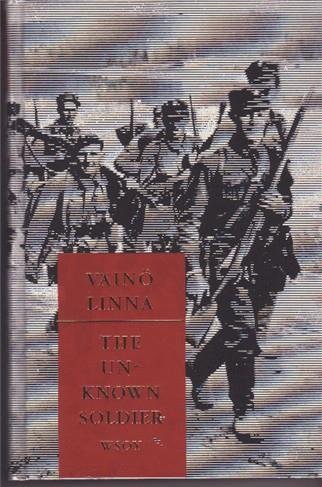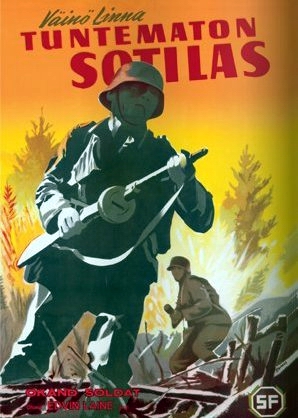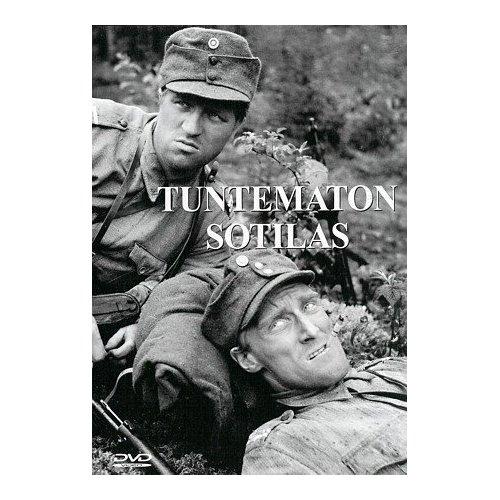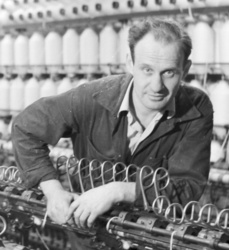The Unknown Soldier (Tuntematon Sotilas) by Väinö Linna
The Unknown Soldier (Tuntematon Sotilas), first published in 1954, was author Väinö Linna’s (1920-1992) first major novel and, whilst almost unknown in the English-speaking world, is, in Scandinavia, widely recognized as among the greatest novels of the twentieth century. In Finland, a country with just over five million people, it has sold over 450,000 copies (the book is Finland’s all-time best-selling novel). It has been translated into 17 languages, filmed twice and is universally regarded a classic of Finnish literature. Linna’s other major work, the “Under the North Star” (Täällä Pohjantähden alla) trilogy, a historical family saga, is more widely known, easily available in English, and shares a few scenes and one major character (Vilho Koskela) with “The Unknown Soldier.” Under the North Star was voted by Finns as the best example of Finnish writing of the 20th century (the title, incidentally, was borrowed from a popular song by Johan Fredrik Granlund). Linna’s lack of greater renown internationally probably reflects the obscurity of the language he happened to write in: Finnish, as well as the poor translation of this great novel into English.

The Unknown Soldier – Väinö Linna
Which brings me to some comments on the English translation (and I paraphrase from various Finnish sources here as I’ve only read the english translation, I’m still struggling with the finnish-language original): while “The Unknown Soldier” is a great novel, apparently the english translation is faulty, with scenes removed and added for unspecified reasons, and (also, based on comments in Finnish reviews) the translation is stylistically misleading as well. Native Finnish speakers do not consider the translation to be faithful to the original Finnish in that in the original the various characters speechs are written in dialect, different characters come from different parts of Finland and so this adds depth to the Finnish version. The final sentence has also been removed due to cold war sensibilities. An “uncensored” version of the book was published in 2000 (In Finnish, not English) under the name Sotaromaani (A War Novel, Linna’s working title), revealing that some of Linna’s critique of the officer corps and the often quite coarse language of the common soldiers had been removed in the original (though much of the so-called censorship seems to have been standard editorial changes and removal of tautology). The only real change is the character of Lehto; in Sotaromaani he was a psychopath, in The Unknown Soldier he was a battle-hardened grunt.
And now: on to reviewing the book itself. The Unknown Soldier is set during the period of the Continuation War (WW2 to the rest of us, but for the Finns, a continuation of the earlier 1939-1940 Winter War where the Soviet Union launched an unprovoked attack on Finland) between Finland and the Soviet Union as told from the viewpoint of ordinary Finnish soldiers. The novel has no single central character, and its focus is on different responses to the experience of war. The work follows the exploits of a single Finnish machine-gun platoon from its mobilization and advance against the Soviets in June, 1941, through to September, 1944 and the bogged-down trench warfare and later bloody retreat from eastern Finland (Karelia) and then the armistice at the end of the war. Much of its events were based on Linna’s own experiences at the front, and the characters had their more or less real-life representatives.
The war unfolds around the men of the platoon, their personalities and quirks are manifested at different times. Many of the characters die or are wounded, as the book is a realistic take on war. There is no central character but the men of the unit all become familiar. The men of the platoon themselves come from all over the country (although in the Englisg language translation this is not particularly evident), unusual in the Finnish Army, where units were normally made up of men from the same region. The men have widely varying social backgrounds and political attitudes, and they all have their own ways of coping, but the general picture is one of a relaxed and businesslike attitude, while the men’s disrespect for formalities and discipline is a source of frustration for some of the officers. The men themselves are all there just to get the job done, and official propaganda, both their own and that of the enemy, is to them a source of amusement or is outright offensive. Linna’s own description of the men in the finnish-language version’s final sentence is “aika velikultia” — something like “they’re good old boys”. The main officer characters are three lieutenants who embody different attitudes: one strict and aloof, one relaxed and fraternal, one idealistic and later disillusioned, but brave and loyal to his men.

Tuntematon Sotilas (The Unknown Soldier) – Väinö Linna
Where Linna really excels is in describing the psychology of his characters. He paints realistic but deeply sympathetic portraits of a score of very different men: cowards and heroes, the initially naive, eventually brave upper-class idealist Kariluoto, the down-to-earth Koskela, the hardened and cynical working-class grunt Lehto, the platoon comedian Vanhala and the preternaturally strong-nerved Rokka, the politically indifferent Hietanen and the communist Lahtinen. It is only the sternest officers of the “Prussian school” for whom he has little love. Many of his characters have come to be seen as archetypes of Finnish men, household names to whom reference can be made without explanation. Rokka, Hietanen, Lahtinen and Koskela, all have become “archtypes”. In public debate, the names of the soldiers are often used as examples without any other reference – for example, an insubordinate but brilliant soldier is referred to as “Rokka.”
The author aimed for a gritty and realistic view of war and of soldiers, and this he achieves admirably. He intended to shatter the myth of the noble, obedient Finnish soldier. In Linna’s own words, he wished to give the Finnish soldier a brain, an organ lacking in earlier depictions — this was a barb directed at Johan Runeberg’s “The Tales of Ensign Stål”, which admiringly portrays Finnish soldiers with big hearts and little independent intellect. It’s a great novel, undeservedly little known outside of Finland, and well worth the trouble of tracking down and acquiring a copy.
Finnish Reviews at the time of publishing were very mixed. The novel caused a scandal when it was first published in 1954 with Conservative critics, most notably Toini Havu in the Finnish newspaper Helsingin Sanomat, condemning it for “adopting a purposely low vantage-point and ignoring the bigger picture”. Finnish politicians, literary critics and patriots were outraged that the novel, which chronicles the experiences of a fictional machine-gun company (though nearly every soldier in the book is based on Linna’s actual war-time acquaintances) in the Continuation War of 1941-1944, depicted Finnish soldiers in a very different manner from other contemporary books at the time. Linna was accused of making an unnecessary spectacle and of dragging the country’s patriotic ideals through the mud, and indeed his purpose had been to take such idealism down a peg.
Other Finnish books on the Second World War written in the same period tended to accept the inevitability of the Continuation War during which Finland fought against the Soviet Union at the same time as the Germans did (but without being allied with the Germans). Whereas earlier books depicted Finnish soldiers as valiant fighters battling hordes of barbarian Communists, Linna’s characters were often shown running for their lives, roaring drunk on home (or rather camp) brewed alcohol, insubordinate towards their superiors and generally mostly unheroic. And indeed, one of Linna’s characters was a Communist! When they died they did so for no real reason, often accidentally or due to bad planning. They were usually scared and sometimes downright cowardly. The language the soldiers used also offended many critics! Linna’s soldiers swore and cursed constantly with almost the full range of Finnish swearwords (again, something that does not come through in the English translation). Critics argued that this “degenerate” behavior was an insult to all those who fought in the war. Other critics recognized Linna’s literary achievement, however, and the public certainly took The Unknown Soldier as their own, making it the all-time Finnish best-seller that it is.
“Modernist” writers at the time of The Unknown Soldier”‘s publication were not happy with its “antiquated” realism. Instead of depicting the internal life of a single individual, Linna focused on a group of people. And Linna’s image of officers and the political leadership was far from flattering to the educated elite of Finland – but struck remarkably close to home, as the sales of the book in Finland illustrated. Linna’s realistic portrayal of Finnish soldiers was attacked by the critics – Linna tried to see the war from the viewpoint of the enlisted man, using dialect, humour, and portraying soldiers without any ostentatious heroism. Toini Havu, in her famous review mentioned previously, criticized the novel in particular for its naturalism and its perspective from below. The fact that this went on to become Finland’s best-selling novel points to Linna having struck a chord with Finn’s in general, far more so than the critics and reviewers.

Tuntematon Sotilas – the original movie
Two movie versions of The Unknown Soldier have been made, one in 1955 and a second one in 1985, both of them staying faithful to the original book. The 1955 film, directed by Edvin Laine, is among the most popular movies in Finland. The 1985 version was directed by Rauli Mollberg. (Incidentally, Laine has also adapted other Linna works to the screen: Musta Rakkaus, published in 1948, became the film Mork Karlek in 1957, and the North Star trilogy was adapted by Laine and made into two films, “Taalla Pohjantahdenalla” in 1968 and “Akseli ja Elina” in 1970). Laine’s film, at that time the most expensive film produced in Finland, was a huge success in Finland. Phrases from “The Unknown Soldier” such as “I’m a Finn, I eat metal and I shit chain” and “One Finn is equal to twenty Russians. But what do you do when the twenty-first comes along ?” and many, many others have become almost proverbs and are apparently often quoted by people without knowing that they are in fact from Linna’s book. It’s a novel with a unique appeal and, no matter how you look at it, as a work of literature, a war story, a critique of war or as a monument to the Finnish soldier – this book stands out their on it’s own.
Lastly, some background on the author himself. Väinö Linna was born into a working class family in Urjala in central Finland. He was the seventh child of a local slaughterman, Vihtori Linna, who died when Väinö was eight years old. His mother, Maija Linna, supported the family by working at Honkola manor. Linna attended public school for six years and left his studies in the mid-1930s. After working in odd jobs, as a farm-hand for the Honkola manor and lumberjack, he moved to Tampere (an industrial city)in 1938, where he was employed by the Finlayson textile mills. Linna spent his spare time in libraries. From 1940 to 1944 Linna served in the Finnish army on the eastern front, fighting as the squad leader of a machine-gun unit. During the Continuation War (1941-44) between Finland and the Soviet Union, Linna wrote a story telling of the regiment’s advance from the Russian border to the east, to the Syväri. In the spring of 1943 he was posted back to Finland as an instructor. He married after the war and returned to his work at the textile factory whilst aiming to become a writer.

Väinö Linna working in textile factory,Tampere
Linna’s first collection of poems did not interest a publisher and Linna abandoned this line of writing. In 1947 his first novel was published, a thinly disguised autobiography entitled PÄÄMÄÄRÄ (the goal). The book sold poorly. Linna’s next novel, “Musta Rakkaus”, was a triangular drama of love, jealousy, and murder set in Tampere. Linna then started a new novel, variously called “The Messiah” or “The Lonely One” about a tubercular factory clerk. The project was interrupted by an emotional crisis. His next novel, which was his breakthrough “The Unknown Soldier”, published in 1954. During the years 1955 to 1964 Linna lived in Hämeenkyrö as a farmer, but he sold the farm in 1964 and moved back to Tampere. The success of “The Unknown Soldie” enabled Linna to devote himself entirely to writing. In 1959 the first volume of his “Under the North Star” trilogy was published. When the North Star trilogy was finished, Linna ceased to write novels, stating that he had delivered his message and had nothing more to say. Two essay collections, Oheisia and Murroksia, were published in 1967 and 1990, respectively. Linna’s literary awards include the State Prize for Literature in both 1959 and 1960, and the Nordic Prize for Literature in 1963. Linna died in Kangasala, Finland, on April 21, 1992.
First and foremost, this review of “The Unknown Soldier” is a bit of a pastiche. In addition to my own comments, I’ve sourced bits and pieces of information on the author, Väinö Linna, from various sources and quoted or paraphrased from a number of reviews from Finnish sources. I hope it presents a good overview of this outstanding novel – as well as some background on both the book and the author that will interest you in reading both this book and the “Under the North Star” trilogy. Both “The Unknown Soldier” and the “Under the North Star” trilogy are great reading!
 Copyright secured by Digiprove © 2013 Alternative Finland
Copyright secured by Digiprove © 2013 Alternative Finland



One Response to The Unknown Soldier (Tuntematon Sotilas) by Väinö Linna